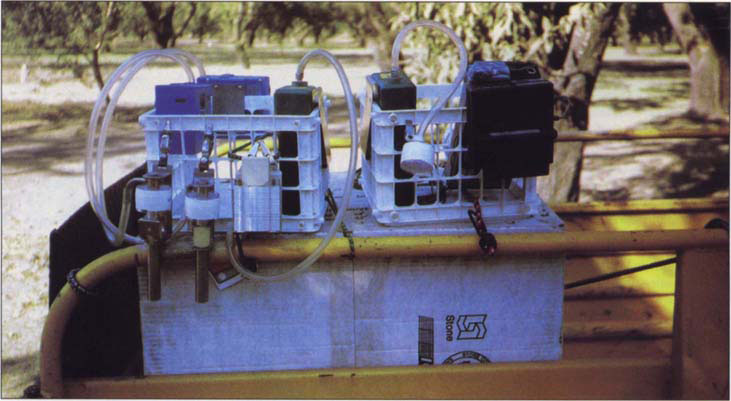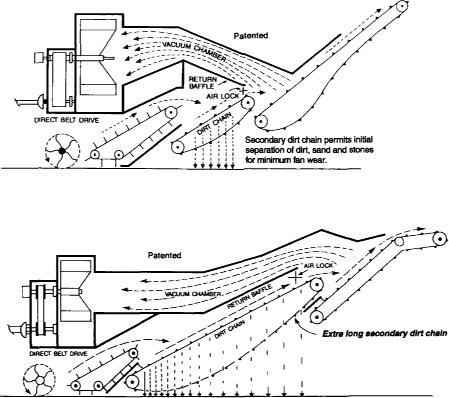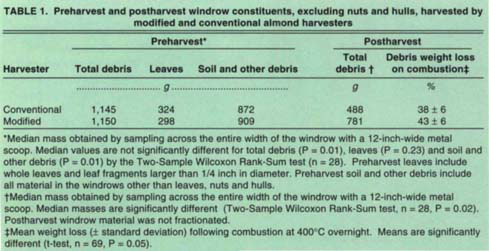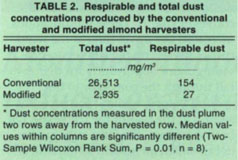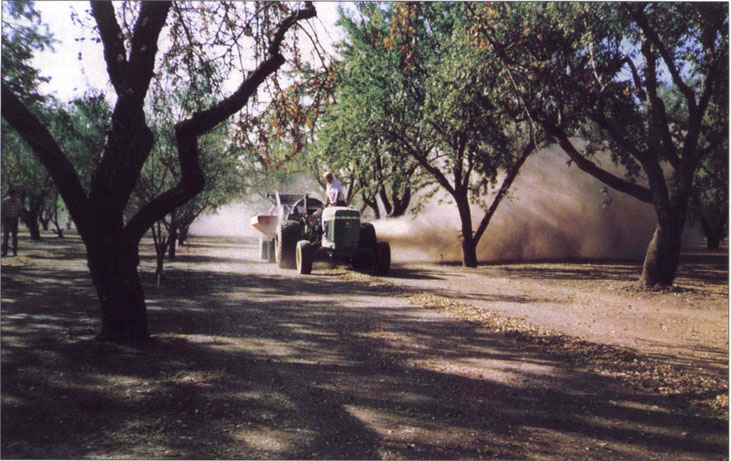All Issues
Modified almond harvester reduces orchard dust
Publication Information
California Agriculture 51(5):10-13. https://doi.org/10.3733/ca.v051n05p10
Published September 01, 1997
PDF | Citation | Permissions
Abstract
Growing concern over the impacts of air quality on human health and the possible links between agricultural production and air quality has sparked interest in determining which agricultural practices produce significant amounts of dust and how dust generation can be reduced. A comparison of the dust generated by a conventional almond harvester with dust generated by a harvester modified to reduce dust was made by measuring particulate matter collected on air sampling filters in an orchard in the Sacramento Valley. Results show that the modified harvester produced significantly less respirable and total dust Equipment modification holds considerable potential to reduce occupational exposure to dust and to reduce impacts of agriculture on ambient air quality.
Full text
Previous work in California's Central Valley and elsewhere has shown that farmworkers exposed to dust may run an increased risk of developing respiratory problems (Gamsky et al. 1992). The federal Occupational Safety and Health Administration (OSHA) has established Permissible Exposure Limits (PEL) for occupational exposure to total dust and to respirable dust (3.5 μm or less in diameter), for both shortterm, acute exposure and long-term, chronic exposure. The federal standards do not apply to agricultural field operations. However, the California Occupational Safety and Health Administration (CAL OSHA) has established stricter PEL for dust that do apply to farmworkers conducting agricultural field operations. (For a summary of these and other current regulations, see page 8 .)
On a broader scale, the impact of agricultural operations on ambient air quality and the general public is under study at UC. Air quality is evaluated relative to the National Ambient Air Quality Standards for concentrations of particulate matter with aerodynamic diameters of less than 10 μm (PM-10) and less than 2.5 μm (PM-2.5). The U.S. Environmental Protection Agency is responsible for enforcing federal regulations relating to ambient air quality. The California Air Resources Board (CARB) has established stricter PM-10 standards for California. Air quality monitoring studies in the intensively cultivated San Joaquin Valley have shown that the CARB standards are frequently violated (Chow et al. 1992), possibly suggesting a need to reduce agricultural dust emissions.
Dust samples were collected on filters held in plastic cassettes connected to battery-powered vacuum pumps. The two samplers on the left are connected to size-selective cyclones that allow sampling of respirable dust. The sampler on the right has no cyclone and measures total dust.
Although it is clear that some PM-10 and PM-2.5 comes from soil sources, it is not clear how much of this soil-derived particulate matter can be attributed directly to agricultural sources, as opposed to roads, dry lakes and uncultivated soils with little vegetation, for example. In an effort to determine the origin and fate of particulate matter, the characteristics of dust emitted from a variety of sources, including almond harvest, are under investigation by UC scientists.
Fig. 1. Schematic diagrams of the conventional (top) and modified (bottom) harvesters. The modified harvester has a longer dirt chain, and the vacuum is applied at a point farther along the conveyor, allowing more windrow material to fall to the orchard floor.
Typical operations during almond harvest include shaking the trees to cause nuts to drop to the ground, sweeping the nuts into windrows between the rows of trees, and picking up the nuts in the windrows with a harvester. The last step generally produces the most dust.
After windrowing, most of the almonds are still enclosed in their hulls. A conveyor (also called a dirt chain) on the harvester picks up all contents of the windrows, but without significantly disturbing the soil of the orchard floor beneath the windrow. The conveyor is designed to allow material smaller than the nuts and hulls to fall through to the ground. The nuts and hulls, along with larger sticks and leaves, are transported by the conveyor through a vacuum chamber that lifts the lower-density debris away from the nuts and hulls and discharges it through a fan. Ideally, only the nuts (with or without hulls) end up in the nut cart that is pulled behind the harvester. The amount of dust produced is mostly a function of how much soil material, leaves and other orchard debris is transported by the conveyor and discharged through the fan.
We compared the amount of dust generated by a conventional nut harvester with the amount generated by a harvester specifically modified to reduce dust production.
Field site characteristics
We did our field sampling in an almond orchard about 3 miles south of Chico. The soils are in a map unit of Conejo loam (Pachic Haploxerolls); surface soils have about 20% clay, were very firm outside the windrows, and exhibited virtually no surface cracking. The orchard had previously been harvested for the Nonpareil variety. We sampled during the harvest of four rows of the Peerless variety, which serves as the pollinator in this orchard and is planted every ninth row. Each tree row was about 3,000 feet long and produced two windrows. These windrows consisted of nuts, hulls, leaves, sticks, gravel, soil material and other miscellaneous debris, and were about 20 to 30 inches wide.
Equipment modification
One of the windrows from each row of trees was harvested with a conventional harvester (Weiss/McNair 8900 Supervac); the other was harvested with a Weiss/McNair 8900X Supervac that had been modified by lengthening the dirt chain and moving the vacuum farther back along the conveyor (fig. 1). These modifications increased the travel time of the windrow materials on the conveyor, providing more opportunity for debris to fall through the conveyor to the ground before reaching the vacuum section at the rear of the conveyor. On both machines, the fan discharged a debris-laden air stream to the side of the harvester and perpendicular to the direction of travel.
Windrow composition
To determine the effect of the harvester modification on dust production, we first determined if the windrows were similar. We used a metal scoop to collect samples from across the full width of each of the eight windrows at 100-foot intervals. These samples were weighed. From these samples, we selected seven samples from each windrow at random and separated them into the following five fractions: whole leaves and leaf fragments larger than 1/4 inch in diameter, nuts, hulls, other material greater than 2 mm diameter (mostly sticks and smaller leaf fragments, with some soil material and a few pebbles), and other material smaller than 2 mm diameter (mostly soil material, with leaf and twig fragments). Each of the five fractions was also weighed. After the nut pickup, we resampled the windrows with the metal scoop. These samples were weighed, but were not fractionated as described above. Selected subsamples were ashed at 400°C in a muffle furnace to estimate organic versus inorganic content.
TABLE 1. Preharvest and postharvest windrow constituents, excluding nuts and hulls, harvested by modified and conventional almond harvesters
TABLE 2. Respirable and total dust concentrations produced by the conventional and modified almond harvesters
Dust measurements
Dust (defined here as all particulate matter, including organic and inorganic materials) was sampled on 37-mm-diameter PVC filters contained in plastic cassettes attached to battery-powered Gilian HFS vacuum pumps. One set of samplers, without size-selective cyclones, sampled total dust. A second set of samplers, with cyclones, sampled dust with a median aerodynamic particle diameter of 3.5 μm We refer to this size of dust as respirable dust, because it is less likely to get intercepted in the nose and more likely to lodge in the lungs.
The size of dust sampled is determined by the pump flow and the geometry of the cyclone. Pump flow was measured with a flow meter before and after sampling. We averaged these rates to ensure uniform operating conditions. The samplers were mounted on a trailer pulled behind a pickup truck two rows away from the harvester, with the samplers positioned in the dust plume (about 1 m above the soil surface). Dust generated by the pickup truck and trailer was very minor compared to the amount generated by either harvester. Filters were changed at frequent intervals to avoid clogging. We obtained one to four filters of each dust fraction (total and respirable) per windrow. Dust plumes were too dense one row from the harvesters, and filters would have clogged almost immediately. Dust concentration (mg dust/cubic meter of air) was calculated from the mass of dust on the filter (calculated by the difference between pre- and postsampling filter masses, measured with a Cahn analytical balance), the pump flow and the sampling duration.
Dust varies by harvester
The composition of the windrows is shown in table 1. Nuts and hulls are not included because they are not blown through the fan and don't contribute to the dust generated in the orchard. These data show that the windrows were very similar prior to nut pick-up. During sampling, there was an observable difference between the dust plumes produced by the two harvesters. Viewed in the direction of harvester travel, the dust cloud from the conventional harvester was generally opaque, and a thick stream of debris flowed from the lower portion of the discharge duct. In contrast, we could see through the dust cloud from the modified harvester, and much more material appeared to be dropping through the conveyor to the orchard floor, thus bypassing the discharge fan.
The modified harvester produced significantly less total dust and significantly less respirable dust than the conventional harvester (table 2). The postharvest windrow masses verify our visual observations that the modified harvester allowed more soil and leaves to fall back to the orchard floor, resulting in reduced dust concentrations.
The postharvest windrows consisted mostly of soil material, leaf fragments and small twigs and buds. These measurements (table 1, postharvest debris) show that the modified harvester returned significantly more material to the windrow than the conventional harvester did. We found that the modified harvester returned about 67% of the soil, leaves and other debris to the windrow, whereas the conventional harvester returned about 40%. The difference is the amount of material that passes through the discharge fan and contributes to dust production.
The postharvest windrow debris contained few whole leaves or large leaf fragments, indicating that they were too big to fall through the openings in the conveyor. A comparison of the weight losses on combustion of the postharvest windrow debris from the two harvesters (table 1) suggests that the modified harvester windrows contained a larger proportion of leaf fragments than the conventional harvester windrows (i.e., proportionately more combustible organic material, hence more weight loss). An additional modification to the harvester might be to increase the size of the openings in the conveyor to allow whole leaves to fall through, while still retaining the nuts.
Modifications to the almond harvester allowed about two-thirds more of the windrow debris to drop to the orchard floor. In a conventional harvester, all the debris passes through the discharge fan and disperses in the air.
Modified harvester reduces dust
Our data show that the conventional almond harvester produced about nine times as much total dust and six times as much respirable dust as the modified harvester. The modifications to the harvester allowed about two-thirds more of the windrow material (not including nuts and hulls) to drop through the conveyor to the orchard floor so that it did not pass through the discharge fan. The results show that relatively simple modifications to harvest equipment can significantly reduce the amount of dust generated. These modifications could reduce the exposure of farm workers to dust, reduce the amount of PM-10 that leaves the orchard and contributes to air pollution downwind, and reduce dust clouds that can obscure the vision of drivers on roads adjacent to orchards.



